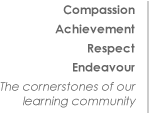
Technology
Design and Technology is a creative and technical subject studied across a wide range of disciplines comprising Food, Graphic Products, Electronics, Textiles and Resistant Materials. We believe that all students should experience a variety of enjoyable and challenging activities that build their knowledge, skills and understanding and learn to apply them to design and make products that solve problems in many different contexts.
Staff Information
| Name | Position / Responsibility | |
|---|---|---|
| Mrs H Froger | Leader of Learning for Technology | hfroger [at] imberhorne [dot] co [dot] uk |
| Mr R Jeffs | KS3 Leader of Technology | rjeffs [at] imberhorne [dot] co [dot] uk |
| Mr J Turner | Leader of Electronics and Careers | jturner [at] imberhorne [dot] co [dot] uk |
| Miss T Green | Technology Teacher | tgreen [at] imberhorne [dot] co [dot] uk |
| Mrs M Lawlor | Technology Teacher | mlawlor [at] imberhorne [dot] co [dot] uk |
| Mr J Rounding | Technology Teacher | jrounding [at] imberhorne [dot] co [dot] uk |
| Mrs S Skinner | Teacher of Food Technology | sskinner [at] imberhorne [dot] co [dot] uk |
FAQs
What do students study in Design and Technology? Is it like woodwork and Home Economics?
Design and Technology has changed enormously over recent years.
The current key stage 3 National curriculum states that:
“Design and Technology is an inspiring, rigorous and practical subject. Using creativity and imagination, pupils design and make products that solve real and relevant problems within a variety of contexts, considering their own and others’ needs, wants and values. They acquire a broad range of subject knowledge and draw on disciplines such as mathematics, science, engineering, computing and art. Pupils learn how to take risks, becoming resourceful, innovative, enterprising and capable citizens. Through the evaluation of past and present design and technology, they develop a critical understanding of its impact on daily life and the wider world. High-quality design and technology education makes an essential contribution to the creativity, culture, wealth and well-being of the nation.”
And adds:
“it aims to ensure that all pupils:
- develop the creative, technical and practical expertise needed to perform everyday tasks confidently and to participate successfully in an increasingly technological world
- build and apply a repertoire of knowledge, understanding and skills in order to design and make high-quality prototypes and products for a wide range of users
- critique, evaluate and test their ideas and products and the work of others
- understand and apply the principles of nutrition and learn how to cook”
It is delivered using a project based approach that allows students to express themselves, applying their technical, creative, planning and practical skills to solve design problems and make quality products.
Skills in wood, metal, plastics, textiles, food, graphic media, computer aided design and manufacture (CAD/CAM) and electronics, to name a few, are taught to support students achieving success in their endeavours.
What type of career can Design and Technology lead to?
Studying Design and Technology can lead to an enormous range of careers, partly dependent on the choice of subject specialism at GCSE and A Level. Skills in Design and Technology can be applied to careers at any level, from manual working, through technician level up to professional level careers such as engineering and architecture.
Studying Design and Technology will also build a wide range of transferrable skills that can be applied in other subject areas and vocations as students are encouraged to think creatively, present their thoughts with clarity, analyse and evaluate products and systems, plan and manage their time and use of resources and pay particular attention to detail and the quality of their work.
Do boys and girls study all the subject areas?
Yes. All students engage in activities in each of the Technology disciplines throughout key stage 3. Students can opt to follow a Design and Technology course at key stage 4 and 5.
Do students have to pay for projects?
At Key Stage 3 we ask for a contribution of £20.00 in Year 7 to help with the cost of materials. This covers all of the materials they will use in years 7, 8 & 9 in all of the Technology areas except Food, where students are expected to bring in ingredients when they are doing practical lessons.
What processes are taught in Design and Technology, do they include CAD/CAM?
We teach students a wide range of processes throughout all of our courses. Traditional making skills in resistant materials, food and textiles allow students to make quality prototypes in each area and we also teach more modern methods and encourage students to use them as appropriate to specific tasks.
Students are also taught to use software packages to enhance and present their ideas, including Photoshop, and 2- and 3-dimensional Computer Aided Design (CAD) packages. We have Computer Aided Manufacturing (CAM) equipment available to and widely used by students in their project work in all key stages, including vinyl cutters, sublimation printers, engravers, 3D printers and a laser cutter.

